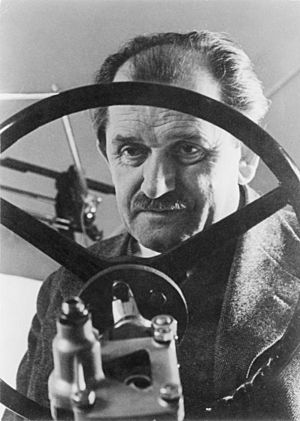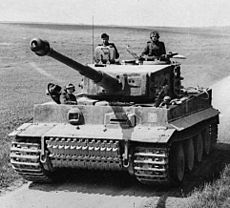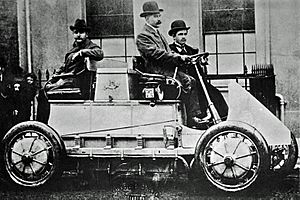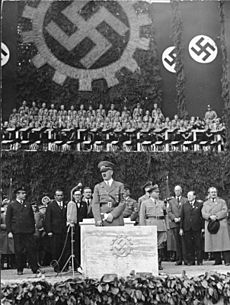Ferdinand Porsche facts for kids
Quick facts for kids
Ferdinand Porsche
|
|
|---|---|

Porsche in 1940
|
|
| Born | 3 September 1875 |
| Died | 30 January 1951 (aged 75) |
| Citizenship | Austria-Hungary (1875–1918) Czechoslovakia (1918–1934) Germany (1934–1951) |
| Occupation | Engineer |
| Children |
|
| Engineering career | |
| Projects | Mercedes-Benz SS/SSK, Tiger I, Tiger II, the Elefant, Panzer VIII Maus and the Volkswagen Beetle |
| Awards | German National Prize for Art and Science (1938) SS-Ehrenring War Merit Cross Wilhelm Exner Medal, 1936 |
| Signature | |
 |
|
Ferdinand Porsche (born September 3, 1875 – died January 30, 1951) was a brilliant car engineer. He came from what is now the Czech Republic. He is famous for starting the Porsche car company.
Porsche also created the first hybrid car, which uses both gasoline and electricity. He designed the famous Volkswagen Beetle. He also helped create important racing cars and military vehicles.
During World War II, Porsche worked on tanks like the Tiger I and Elefant. He was a member of the Nazi Party and an officer in the Schutzstaffel (SS). After the war, he was held for a time.
In 1996, Ferdinand Porsche was added to the International Motorsports Hall of Fame. In 1999, he was named the Car Engineer of the Century.
Contents
Early Life and Big Dreams
Ferdinand Porsche was born in Maffersdorf, a town that is now part of the Czech Republic. He was the third child of Anton Porsche, who was a master metalworker.
From a young age, Ferdinand loved technology, especially electricity. He went to night classes at a technical college while helping his father during the day.
At 18, he moved to Vienna and got a job at an electrical company. He also studied part-time at the Vienna University of Technology. Even without a formal engineering degree, he learned a lot.
While working there, he built an electric wheel-hub motor. He even raced a car with his new motor in 1897. After World War I, he became a citizen of Czechoslovakia. Later, in 1934, he became a German citizen.
Starting His Career in Cars
In 1897 or 1898, Porsche joined Jakob Lohner & Company in Vienna. This company made fancy carriages for kings and queens. Lohner had just started building cars.
Their first car design was the Egger–Lohner vehicle in 1898. It was like a carriage but powered by two electric motors in the front wheels. These motors got power from heavy batteries.
In 1901, Porsche created the "Lohner–Porsche Mixte Hybrid." This car was special because it used a gasoline engine to power a generator. The generator then powered the electric motors in the wheels. It also had a small battery for backup. This was the first ever gasoline-electric hybrid car!
Over 300 Lohner–Porsche vehicles were sold by 1906. Most were trucks, buses, or fire engines. These vehicles could go up to 56 kilometers per hour. They even won speed records and a rally race in 1901.
In 1905, Porsche was named Austria's best car engineer. The next year, he worked as a chauffeur for Archduke Franz Ferdinand. This Archduke's death later helped start World War I.
Leading Car Companies
In 1906, Porsche became the chief designer at Austro-Daimler. He designed a famous car for the Prince Henry Trial in 1910. This car won the top three places in the race.
By 1916, Porsche was a managing director. He also received an honorary doctorate degree from the Vienna University of Technology. He kept designing successful racing cars. In 1922, his designs won 43 out of 53 races.
In 1923, Porsche left Austro-Daimler due to disagreements. A few months later, Daimler Motoren Gesellschaft hired him as Technical Director in Stuttgart, Germany. Stuttgart was a big center for car making.
He received another honorary doctorate in 1924 and was given the title of Professor. While at Daimler, he designed many successful race cars. The Mercedes-Benz SSK was one of his most famous designs.
In 1926, Daimler merged with Benz to form Daimler-Benz. Porsche wanted to build a small, light Mercedes-Benz car, but the company's board did not agree. He left in 1929 and worked for Steyr Automobile. However, the Great Depression caused him to lose that job.
Starting His Own Company: Porsche
In April 1931, Ferdinand Porsche returned to Stuttgart. He started his own company called Dr. Ing. h.c. F. Porsche GmbH. This company offered design and consulting services for engines and vehicles.
He got financial help from his son-in-law, Anton Piëch. Porsche also hired many former co-workers, including his son, Ferry Porsche.
Their first project was designing a car for the Wanderer company. As his business grew, Porsche decided to work on his own car design. This was a smaller car idea he had from his time at Daimler-Benz.
He also started a special company, Hochleistungs Motor GmbH, to build a racing car. This racing car, called the P-Wagen, was designed to be very light.
In 1932, several car companies formed Auto Union. The chairman, Klaus von Oertzen, wanted a special project. Porsche met with him. In 1933, German Chancellor Adolf Hitler announced plans to make cars available to everyone. He also wanted to support German motor racing.
These plans led to two big projects for Porsche. He also worked on other projects for the German government, including tank designs.
The Volkswagen Beetle and Government Work
In June 1934, Hitler gave Porsche a contract to design a "people's car," or "Volkswagen". Porsche had already worked on similar designs. The first two prototypes were ready in 1935.
The Volkswagen car was similar to designs by Hans Ledwinka of Tatra. This led to a lawsuit, but it was stopped when Germany took over Czechoslovakia. After World War II, Volkswagen paid a settlement.
Porsche was praised as a great German engineer. In 1934, he became a German citizen. In 1937, he joined the Nazi Party and the SS. He even used the SS for security at his factory. During the war, he received awards.
A new city, "Stadt des KdF-Wagens," was built for the Volkswagen factory. Today, this city is called Wolfsburg and is still Volkswagen's headquarters. During the war, the factory mainly built military vehicles like the Kübelwagen and Schwimmwagen. The famous Beetle car was mass-produced after the war ended.
Auto Union Racing Cars

German racing driver Hans Stuck met Hitler and helped arrange a meeting between Hitler, Porsche, and others. Hitler agreed that two companies should develop racing cars for Germany's glory. He split money between Mercedes and Auto Union.
Auto Union bought Porsche's racing car project. As Porsche became busy with the Volkswagen factory, his son, Ferry, took over the racing projects. The powerful "Silver Arrows" racing cars from both Mercedes and Auto Union ruled the tracks until World War II began in 1939.
Military Vehicles
In 1942, Porsche designed a heavy tank called the VK4501, also known as "Tiger (P)". Another company's design was chosen for production instead. However, ninety of Porsche's tank chassis were turned into self-propelled anti-tank guns. These were called the Panzerjäger Tiger (P) and nicknamed "Ferdinand."
The Ferdinand tank destroyer used a hybrid electric engine. It had a powerful 88mm gun. These vehicles were very effective in battle. However, they often got stuck or broke down. Crews sometimes had to destroy their own vehicles to prevent them from being captured.
After the War
In November 1945, France asked Porsche to help continue the Volkswagen design. They also wanted to move the factory equipment to France as part of war payments. Porsche was also asked to help with the design of the upcoming Renault 4CV car.
On December 15, 1945, French authorities arrested Porsche, Anton Piëch, and Ferry Porsche. They were suspected of being war criminals because of their work during the war. Ferry was released after six months, but Ferdinand and Anton were held longer.
While his father was in prison, Ferry worked hard to keep the company going. He started a business repairing cars and other machines. They also got a contract to design a racing car, the Type 360 Cisitalia. This car had an innovative four-wheel-drive design.
The Porsche family later said their arrest was an attempt to get money from them. However, it was found that about 300 forced laborers, including Poles and Russians, worked at their factory during the war. Many German factories used forced labor at that time. The French government asked for a payment of one million francs for Porsche's release. The family raised this money through their contract with Cisitalia.
Besides the Cisitalia project, the company also began designing a new car. This was the Porsche 356, the first car to carry the Porsche brand name. The company moved to Gmünd, Austria, to avoid Allied bombing. They built 49 of these cars by hand in an old saw mill.
Return to Stuttgart and Success
The Porsche family returned to Stuttgart in 1949. They weren't sure how to restart their business. Banks would not lend them money because their factory was still under embargo.
So, Ferry Porsche took one of the Gmünd-made 356 cars. He visited Volkswagen dealers and asked them to pay for new cars in advance. This helped them get the money they needed.
The new Porsche 356 cars made in Stuttgart had a steel body. Over the next 17 years, more than 78,000 Porsche 356s were made.
Volkswagen also hired Porsche for more consulting work. He received a payment for every Volkswagen Beetle made. This gave him a good income, as over 20 million Beetles were built.
In November 1950, Porsche visited the Volkswagen factory in Wolfsburg for the first time since the war. He talked with Volkswagen president Heinrich Nordhoff about the future of the Beetle.
A few weeks later, Porsche had a stroke. He did not fully recover and passed away on January 30, 1951.
His Ideas on Work
Ferdinand Porsche visited Henry Ford's factories in Detroit many times. He learned how important it was to be productive. He was surprised that workers and managers treated each other as equals. Even he, as a visitor, had to carry his own tray in the cafeteria.
Increasing productivity became a key interest for Porsche. This meant finding ways to work more efficiently. The Volkswagen project needed a large workforce. The Volkswagen plant was finished in 1938 with the help of Italian workers.
During World War II, Volkswagen, under Ferdinand Porsche, used forced labor. This included many Soviet prisoners. By early 1945, German workers made up only 10% of Volkswagen's workforce.
See also
 In Spanish: Ferdinand Porsche para niños
In Spanish: Ferdinand Porsche para niños
- Arthur Constantin Krebs, a director at Panhard who worked with Ferdinand Porsche on a hybrid car.
Images for kids





